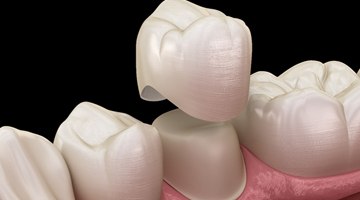Crown
Dental Crowns
A crown is a custom made cap that fits over a tooth. Normally this is to prevent the tooth from further fracture in the future, especially if the tooth is heavily filled or has undergone root canal treatment. Crowns can be made in metal/gold or tooth coloured crowns can be made from porcelain and/or zirconia.
Crowns are used to improve the appearance and function of discoloured, weakened, or irregular teeth. They are fixed to an existing tooth or dental implant, capping or surround them depending on the circumstances.
Most common types of crowns in modern dental practice are:
- Ceramic crowns – with a good strength and good aesthetics. They applied mostly in front areas of the dental arch.
- Zirconium crowns – biocompatible with excellent aesthetics and durability (very high strength). Apply to the entire dentition.
- Metal crowns – healthy but unaesthetic. Applied in the final occlusal areas in lack of space.
To help you make an educated decision regarding dental crowns, here are some of the pros and cons of this procedure:
Request a Consultation
A dental crown may be needed in the following situations:
- To protect a weak tooth (for instance, from decay) from breaking or to hold together parts of a cracked tooth
- To restore an already broken tooth or a tooth that has been severely worn down
- To cover and support a tooth with a large filling when there isn’t a lot of tooth left
- To hold a dental bridge in place
- To cover misshapened or severely discolored teeth
- To cover a dental implant
- To make a cosmetic modification
Preparing a tooth for a crown usually requires two visits to the dentist — the first step involves examining and preparing the tooth, the second visit involves placement of the permanent crown.
First visit: Examining and preparing the tooth
At the first visit in preparation for a crown, your dentist may take a few X-rays to check the roots of the tooth receiving the crown and surrounding bone. If the tooth has extensive decay or if there is a risk of infection or injury to the tooth’s pulp, a root canal treatment may first be performed.
Before the process of making a crown begins, your dentist will anesthetise (numb) the tooth and the gum tissue around the tooth. Next, the tooth receiving the crown is reshaped along the chewing surface and sides to make room for the crown. The amount removed depends on the type of crown used. If, on the other hand, a large area of the tooth is missing (due to decay or damage), your dentist will use filling material to “build up” the tooth to support the crown.
After reshaping the tooth, your dentist typically will use a paste or putty to make an impression of the tooth to receive the crown. Sometimes, though, impressions are made with a digital scanner. Impressions of the teeth above and below the tooth to receive the dental crown will also be made to make sure that the crown will not affect your bite. If the crown is made of porcelain or zirconia, your dentist will also select the shade that most closely matches the colour of the neighbouring teeth.
The impressions or scans are sent to a dental lab where the crown will be manufactured. The crown is usually returned to your dentist in two to three weeks. During this first visit your dentist will make a temporary crown to cover and protect the prepared tooth while the crown is being made. Temporary crowns usually are made of acrylic and are held in place using a temporary cement.
Second visit: Receiving the permanent dental crown
At the second visit, your dentist will remove the temporary crown and check the fit and colour of the permanent crown. If everything is acceptable, a local anaesthetic will be used to numb the tooth and the new crown is permanently cemented in place.
- Avoid sticky, chewy foods (for example, chewing gum, caramel), which have the potential of grabbing and pulling off the crown.
- Minimize use of the side of your mouth with the temporary crown. Shift the bulk of your chewing to the other side of the mouth.
- Avoid chewing hard foods (such as raw vegetables), which could dislodge or break the crown.
- Slide rather than lift out dental floss when cleaning between your teeth to avoid pulling off the temporary crown.
Your newly crowned tooth may be sensitive immediately after the procedure as the anaesthesia begins to wear off. If the tooth that has been crowned still has a nerve in it, you may experience some heat and cold sensitivity. Your dentist may recommend that you brush teeth with toothpaste designed for sensitive teeth and it should be transient.
How long your crown lasts depends on how well you look after it. Properly cared for crowns should last for many years. Your dental team will be able to tell you how long your crown may be expected to last.
It is important to keep the crown just as clean as you would your natural teeth. The crown itself cannot decay, but decay can start where the edge of the crown joins the tooth. Brush last thing at night and at least one other time during the day with a fluoride toothpaste, and clean in between your teeth with ‘interdental’ brushes or floss.
No. You will have a local anaesthetic and the preparation work should feel no different from a filling. If the tooth does not have a nerve, and a post crown is being prepared, then you may not need a local anaesthetic.



